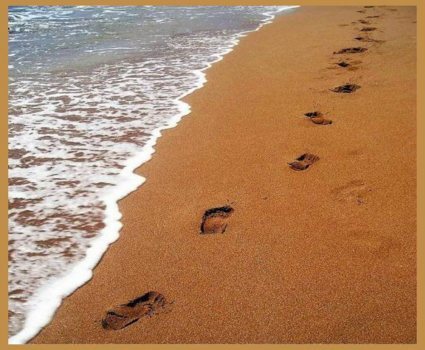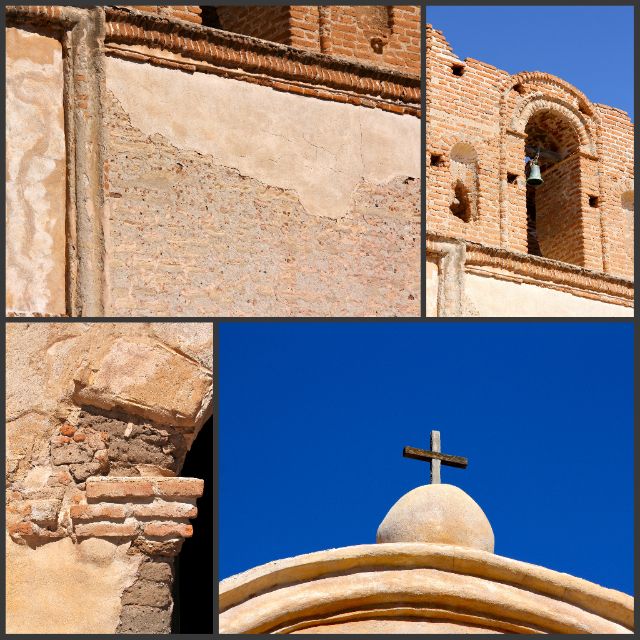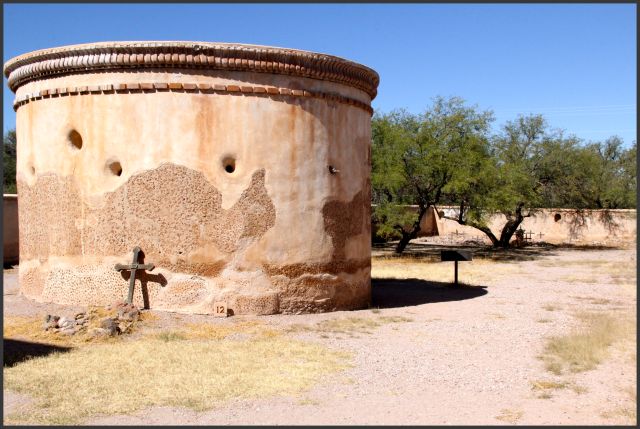Fast forward several decades. Friends mentioned they went to Tumacácori and Tubac and had a fabulous time. I was skeptical thinking that Tumacácori was an Indian ruin and this was a trick to get me to break my vow. Then another decade or so later I discovered, while reading an Arizona Highways magazine, that Tumacácori was not an Indian ruin but a mission and contributed greatly to Arizona's history. When I made my "100 Things in Arizona" list, it was #41 - and we visited it this fall.
The first stop is the visitor's center where friendly rangers helped us plan our visit to fit the time we had available. We also picked up a guide book before heading out the back door and into the past.
A beautiful garden with plenty of shade and benches separated the visitor's center from the museum building (lower left).
In the late 1600's Father Kino, a Jesuit missionary, renamed the O'odham village called Tumacácori located on the east side of the Santa Cruz River calling it Cayetano (Spanish). He celebrated the first mass there in a ramada built by the Indians. This newly established mission, a community for converting the natives to Christianity, became San Cayetano de Tumacácori. Although we usually use "church" and "mission" synonymously, Tumacácori did not have a real church building until after the Pima Rebellion in 1751 when the community was moved to its present site on the west side of the river to be near the newly established Tubac Presidio for protection. Its name was changed to San José de Tumacácori and the new church was finished in1757. The church we see today was built by the Franciscans between 1800 and 1822 long after Father Kino had died (1711).
The long path leading from the museum to the church gave me time to really look at the church, to imagine what life would have been like back when it was built. Underneath the mound to the left of the path are the foundations of O'odham houses.
The O'odham people made adobe bricks from the clay-like soil mixed with gravel and water. Limestone was quarried from the Santa Rita mountains about 30 miles away (seen in the right side of the photo above) to be used to make plaster for the walls. And still others grew crops for food and trading.
Some of the original adobe bricks are visible where the limestone plaster has eroded away. Exterior restoration of the church has been extensive although great care has been taken to maintain the authenticity of the building. For example, the bell in the bell tower has been replaced but is of similar size and material as the original one.
The interior of the church is laid out in the form of a long hall rather than a cross. There were no pews; people stood or knelt during the services. From the nave, steps lead up to the sanctuary where the priest celebrated the Mass. The original paints, picture frames and extensive stenciling are still visible giving a glimpse of its former beauty.
The cross made of flowers was the only modern adornment. A worker was busy doing reconstruction but graciously moved for my picture-taking.
The roof was removed after the church was abandoned and the wood used for other buildings. It has been replaced several times since then. This view, looking back into the nave from the sanctuary, shows the deterioration of the walls in many places.
The church was abandoned in 1848 and changed from a house of worship to just a house. People traveling through the area could not resist the lure of a warm place to stay out of the elements. Weary "49ers" on their way to the California Gold Rush, Mexican soldiers and cowboys all spent nights in the church, especially in the sacristy, a kind of storeroom where the priests kept the clothing and articles used in the performance of their duties. It was also where the priests mentally prepared themselves to be servants of God and where they kept church records of baptisms, marriages, burials and the like. As time went on, US soldiers and cowboys also stayed in the sacristy and like those before them, they recorded their stay on the walls. Sometimes they died there, too - and were buried on the grounds.
Just outside the church is the mortuary chapel and graveyard. The grave markers are all 20th century. Mission-era graves were destroyed long ago by weather, treasure hunters and cattle - the cemetery was used as a corral during long cattle drives at the end of the 19th century.
The mission was truly a community and provided not only for the people's spiritual needs but also for their physical needs. The Spanish priests brought sheep, goats, cattle, wheat and fruit trees which provided a much greater variety to the O'odham diet. Food was dried, stored in clay jars and baskets in the granary for distribution to the people throughout the year.
The roof to the granary also "disappeared" after the church was abandoned.
The foundation in front of and to the left of the church is all that remains of the original church. The building to the right of the church is the front of the granary and just behind it is the mortuary chapel and graveyard. This was definitely a community with social structure.
The museum is filled with interesting displays and artifacts depicting life at Tumacácori from its inception to abandonment. One thing I found interesting was the origin of the tortilla. Aztecs made a flat, round, yellowish bread out of corn. The Spaniards had never seen corn but made a yellowish omelette out of eggs that they called a tortilla. Having no other word for the Indian cornbread, the Spanish called it a tortilla. This "Mexican" tortilla continued to evolve with the Spanish introduction of wheat. It is truly a blending of the two cultures.
Unlike the vacation from my childhood, this trip was interesting and fun. And, to be honest, it did have ruins if you count the foundation from the first church. Perhaps with age comes wisdom and the ability to better appreciate other cultures.
Thumb Up or Down: Up!!
Miles Round Trip: 294.2 miles
Miles To Date: 10,619.7 miles
Percent of List Completed: 92%
Date of This Trip: October 26, 2012









We visited Tumacácori when we lived in AZ. I'll have to dig up the photos, but believe there was a graveyard there that I photographed and have planned to paint for year. I just haven't figured out the right way to do it to make it interesting.
ReplyDeleteThere is a graveyard but it is now in disrepair. The view of the mortuary chapel with the fence and gate in the backyard had some interesting lines and shading. I can't wait to see what you do with your photo.
Delete